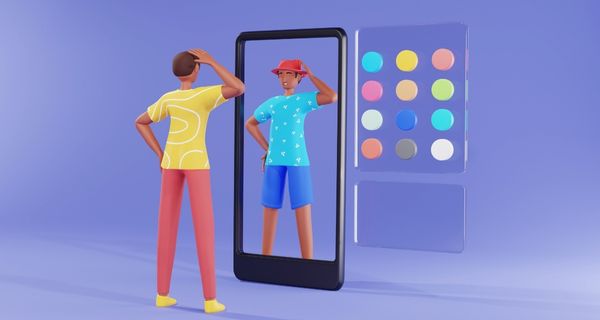The Future is Now: Transforming Design with 3D Visualization
 PlugXR
PlugXRIn an era where the digital and physical worlds are increasingly intertwined, the realms of design, architecture, and visual arts have found a remarkable ally in the form of 3D visualization. Gone are the days when blueprints and mock-ups were the primary tools for design conception. Today, architects and designers are harnessing the power of 3D visualization to create virtual worlds that push the boundaries of imagination and realism.
This comprehensive blog post explores the burgeoning field of 3D visualization, discussing its impact on various industries and the evolving technology that powers it. Whether you're an architecture enthusiast, a graphic designer, or a 3D artist, this deep-dive into 3D visualization is a must-read to stay abreast of the latest innovations steering the course of design.
What is 3D Visualization?
At its core, 3D visualization is the process of creating graphical content using three-dimensional (3D) technology. It involves the generation of 3D representations of objects or scenes through specialized software, often as a means of design prototyping, simulation, and rendering.
Unlike traditional 2D images, 3D visualization allows for manipulation and observation from any angle—a fundamental shift that has redefined how we perceive and interact with visual data. It provides a detailed, realistic view of a proposed design and is instrumental in illustrating spatial concepts and augmenting client presentations.

The Evolution of 3D Visualization
The evolution of 3D visualization has been prolific, owing much to advances in computer processing power and graphics rendering capabilities. From the early wireframe models and flat-shaded objects of the 1970s and '80s, 3D visualization has seen unprecedented growth in its realism and complexity, through developments like texture mapping, ray tracing, and global illumination.
Today's 3D visualizations are often indistinguishable from photographs, blurring the lines between the real and the virtual. In architecture and design, this level of fidelity is crucial for eliciting client buy-in and understanding complex spatial relationships that underpin modern building projects.
Revolutionizing Architecture and Urban Planning
The architectural community has embraced 3D visualization as a transformative tool, reshaping how we conceptualize and construct the built environment. By offering photorealistic renditions of buildings and landscapes, architects can now communicate design intent with a precision once reserved for physical models or the finished structure.
Design Development and Iteration
3D visualization streamlines the design process by facilitating quick iterations and adjustments. Early-stage conceptual models can morph into fully-fledged designs, all within a digital space. This agility not only speeds up project timelines but also encourages exploration of various design options, leading to more innovative solutions.
Interactive Virtual Tours
One of the most significant advancements facilitated by 3D visualization is the ability to create interactive virtual tours. Stakeholders and clients can immerse themselves in a proposed space, 'walk' through buildings, and experience design elements in real time. This level of interactivity enhances the decision-making process, as feedback can be elicited and changes visualized on the fly.
Urban Planning and Development
In urban planning, 3D visualization is breaking new ground in public engagement. With detailed models of cityscapes, planners can illustrate the impact of proposed changes, such as new infrastructure or zoning regulations, on the urban fabric. This not only fosters a better-informed public but can also lead to more responsive and inclusive urban developments.
Empowering Product Design and Marketing
Beyond architecture, 3D visualization is a dominant force in product design and marketing. By creating lifelike depictions of products in various contexts, it is a powerful tool for communicating brand vision and differentiating products in the market.
Prototyping and Manufacturing
Product designers leverage 3D visualization to create virtual prototypes that can be tested and refined without the need for physical materials. This reduces the cost and time associated with traditional prototype development, offering a more efficient pathway to market.
Enhanced Marketing Strategies
In marketing, 3D visualization is revolutionizing how products are showcased. Instead of traditional product photography, which can be costly and restrictive, brands can now create and place their products in any environment or lifestyle scene. This flexibility is a game-changer in creating marketing materials that resonate with diverse audiences.
Illuminating the World of Art and Graphic Design
The influence of 3D visualization extends to the broader spectrum of the visual arts and graphic design. Artists and designers are using these tools to push creative boundaries and create work that transcends traditional 2D mediums.
Digital Sculpting and Painting
With the advent of digital sculpting software, artists can create intricate 3D models with the precision of sculpting, but with the infinite malleability that digital technology offers. These models form the basis for 3D printing, producing physical representations of digital art.
Visual Effects and Animation
The world of cinema and multimedia is no stranger to the magic of 3D visualization. From special effects that make the impossible seem real to entire animated worlds, the applications in visual media are as varied as they are impressive. 3D visualization has become an integral part of storytelling, enriching narratives with immersive visuals that captivate audiences.
Graphic Design and Branding
In the realm of graphic design and branding, 3D visualization offers a fresh approach to creating logos, packaging, and advertising materials. By adding depth and perspective to designs, 3D elements can make graphics stand out and create a lasting impression in the minds of consumers.
The Technological Backbone: Software and Hardware
Harnessing the power of 3D visualization requires an understanding of the software and hardware that make it possible. From powerhouse computers and rendering farms to a multitude of specialized software, a robust technical infrastructure is the backbone of any 3D visualization endeavor.
Industry-Standard Software
Autodesk's suite of tools, including AutoCAD and 3ds Max, stands as a stalwart in the field. Meanwhile, newer entrants like Blender, an open-source platform, are democratizing 3D design. Each software comes with its own learning curve and specialized application, catering to the diverse needs of industry professionals.
High-End Hardware Solutions
The demands of 3D visualization place significant strain on hardware, particularly in terms of processing power and memory. High-performance workstations with dedicated graphics cards are common in the industry. Meanwhile, the advent of real-time rendering engines like Unreal Engine and Unity is pushing the envelope of what is possible on standard equipment.
The Future of 3D Visualization: Trends and Projections
The trajectory of 3D visualization is heading toward an even more integrated and immersive future. Emerging trends point to a convergence of technologies, where virtual reality (VR) and augmented reality (AR) will provide new dimensions of experience and interaction with 3D visualizations.
Virtual Reality for Design and Experience
VR technology has the potential to redefine how we experience and interact with 3D visualizations. Architects could walk through their creations at a one-to-one scale, and designers could make choices on materials and textures in a more natural, visual way. The implications for training, simulation, and entertainment are also profound.
Augmented Reality for Real-Time Visualization
AR overlays 3D graphics onto the real world, enhancing our immediate surroundings. In industries like retail and interior design, AR can allow consumers to visualize products in their homes before purchase. For architects and urban planners, AR can offer real-time overlays of designs onto existing environments, aiding in decision-making processes and public engagement.
Conclusion: The 3D Visualization Imperative
In a landscape defined by constant change and innovation, 3D visualization is more than a fleeting trend—it is an imperative. The ability to visualize, iterate, and bring to life designs in a three-dimensional space is a skill that will be increasingly sought-after across a myriad of industries.
For professionals looking to stay relevant, continuous learning and upskilling in 3D visualization tools and techniques are non-negotiable. By understanding the breadth of impact and potential that 3D visualization offers, creatives can carve out a future where their designs are limited only by the scope of their imagination.
The next frontier of 3D visualization awaits, and the pioneers are those that grasp the tools of tomorrow, today. As we stand on the cusp of a visual revolution, the only question that remains is, "How will you shape the 3D world around you?"
Absolutely! No-code AR platforms like PlugXR can indeed be a game-changer for anyone looking to explore augmented reality (AR) without diving deep into coding.
Subscribe to my newsletter
Read articles from PlugXR directly inside your inbox. Subscribe to the newsletter, and don't miss out.
Written by

PlugXR
PlugXR
PlugXR is a platform for anybody with or without technical skills to create immersive Augmented Reality, Virtual Reality, Mixed Reality, and Spatial Computing without coding.